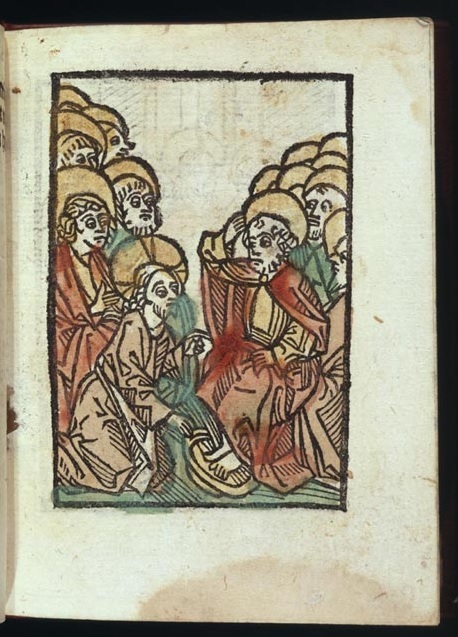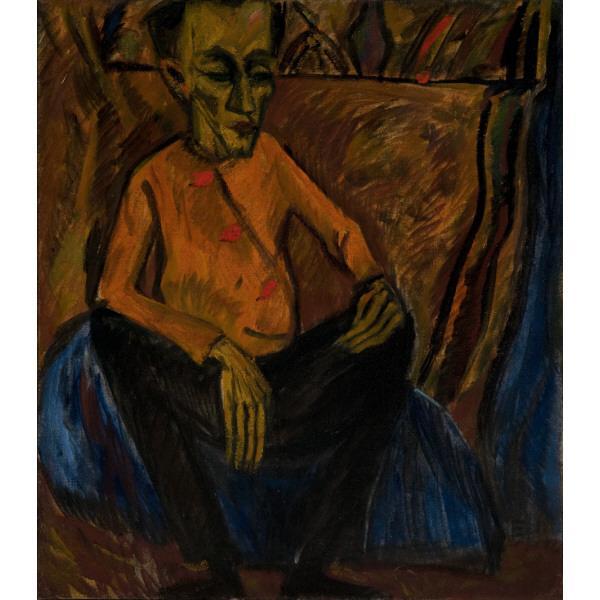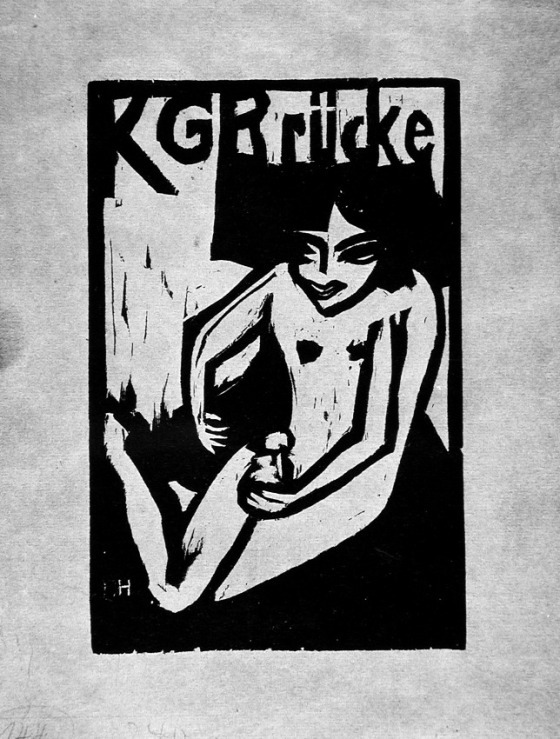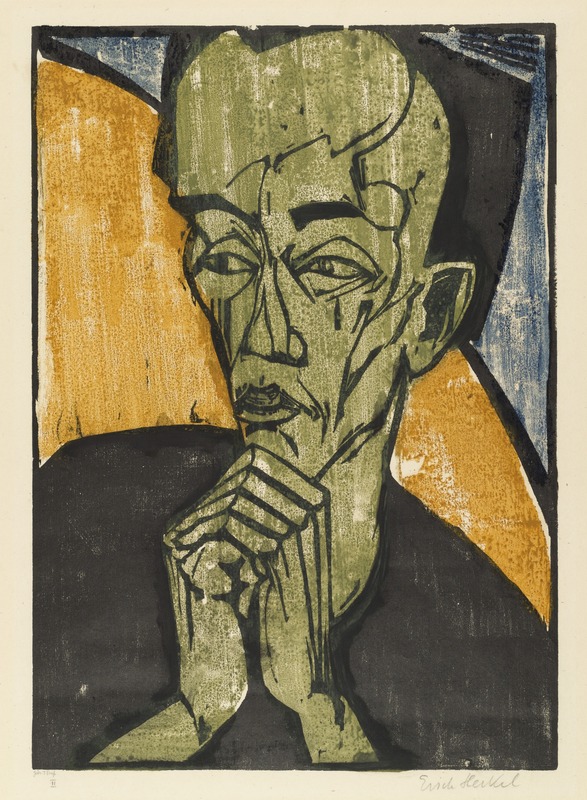Erich Heckel: Man in Brown
Erich Heckel's 1913 painting Man in Brown (Figure 7) is a dark portrait painted in muddled browns, oranges, and blues. Depicting a man crouching or sitting cross-legged, Heckel's sharp diagonal strokes add a dynamism to the paint which contrasts with the sedated pose of the subject, suggesting an internal and psychological element to the piece. The main focus of the piece is the titular “Man in Brown”, whose shirt is actually closer to a stained orange. The seated man occupies a central and vertical space within the painting. The man's proportions are stretched and distorted: his fingers are long and alien, his face extended and angular, and his body extends outside the physical limits of the canvas. Heckel flattens the space to draw the viewer's attention to the main figure and away from the objectless and uninteresting background. Focusing on the man forces the viewer to question his story: who is this man? Why is he sitting in a dirty alley? What is he thinking? The seated man's face betrays little of his thoughts or emotions; he seems equal parts serene and bored. The ambiguity of the scene and of the man's expression force the viewer to question who he is and what his importance may be, thereby drawing them into direct engagement with the work.

Example of early German Woodcut
Passio domini Jesu Christi
Johann Schönsperger
February 22, 1490
Rosenwald Collection, Rare Book and Special Collections Division, Library of Congress
Heckel was a founding member of Die Brucke artists' group who sought to “bridge” the gap between older forms of German expression and newer expressionist art styles while rejecting the prescriptive rules of classical art (Note 8). Heckel's stylization of the face of the Man in Brown grows from his earlier experimentation with revival of woodcut (a medium Die Brucke members considered an influential part of German tradition) and non-Western art, with its mask-like features. Heckel's 1910 woodcut KG Brücke (Figure 8) depicts a nude woman cradling a tiny child, the child depicted as barely more than a handful of curved lines. The woman's face is remarkably angular, with sharp but non-individualized features. Although his depiction of the female nude was controversial, his use of woodcut refers to German heritage (Note 9). Heckel was clearly experimenting with angular stylization of faces before he painted Man in Brown, but the medium of painting allowed him greater freedom to explore the psychology of his figures. While the man in this work's face is sharp, angular, and non-individualized like the woman's face in KG Brücke, the sickly wash of green, brown, and touches of orange paint which describe the Man in Brown's face add a sense of heightened emotion. Heckel depicts the man's eyelids as heavy and hooded, shrouding the man's eyes in blackness. Rather than resorting to depicting the bridge of the nose and the mouth as woodcut gashes, the medium of oil paint allows Heckel to delineate these forms to add a sense of fullness and weight, rather than as simply a large patch of black. In this face, Heckel is truly bridging the gap between the traditional medium of woodcut and newer styles of Expressionist painting.
Practically the only sense of three-dimensionality within Man in Brown occurs in the man's chin, which juts out over part of his neck and shirt. Even though some objects appear in front of one another, the man's hands lie in front of his pants and the man occupies a space in front of the background, all of these objects are painted as if they occupy the same plane withing the painting. Man in Brown is altogether highly flattened and compressed image whose only sense of dimensionality is found within the man's face. Heckel's use of space subtly draws upwards towards the seated man's face, causing the viewer to carefully study the angular features and obfuscated expression. The way the face occupies space within the work draws viewer attention away from the man's (comparatively) bright orange shirt, even though it is painted with the same dull tones and values as the background. Drawing attention to the man's face again, forces the viewer to consider the psychological aspects of the man depicted.
Heckel's depiction of the human face and body in Man in Brown differs substantially from works he produced later in his career. In his 1919 woodcut piece entitled Portrait of a Man (Figure 9), Heckel bring the viewer very close to a man's face. Although the man is looking away from the viewer, the lack of distance and close cropping provides a personal and intimate experience. Additionally, Heckel carefully and skillfully delineates the details of the man's face in his 1919 work. While still extremely sharp and angular, the man in Heckel's later work is depicted with a lighter touch, allowing finer details and personalized features to show through. Portrait of a Man especially stands in contrast to KG Brücke as they are both woodcuts, however the earlier work is heavy and dark while the later is light and crisp in its depiction of the human form.
Man in Brown shows Heckel and Die Brücke artists' goal of bridging the gap between tradition and innovation. Drawing inspiration from earlier woodcuts and primitive art, Heckel creates a non-individualized portrait through distinct, angular exaggerations of human facial features. Drawing attention to the man's face through subtle use and manipulation of space, Heckel guides the viewer towards direct engagement with the work whose psychological impact is heightened by the contrast between the man's blank expression and the thick and painterly application of pigment. Heckel forces viewers to imagine a story for or to attribute an inner mental state to the man because we are given so few clues as to the true nature of the man and the space he occupies.



